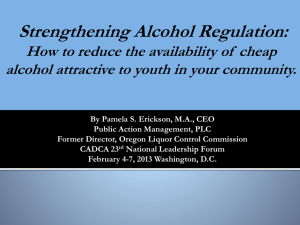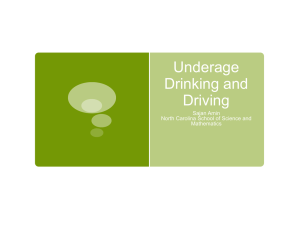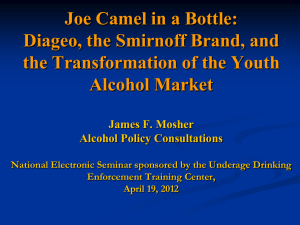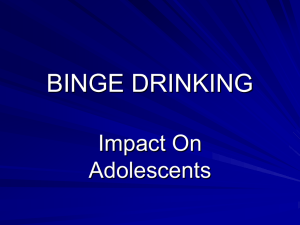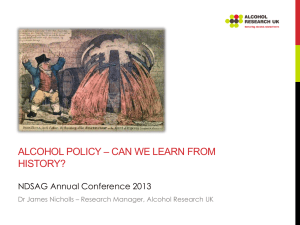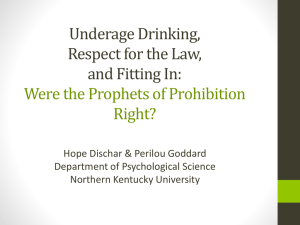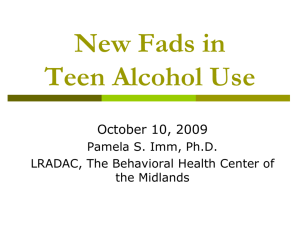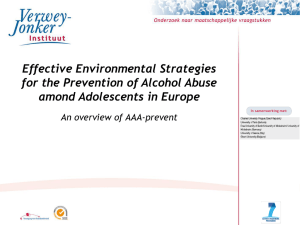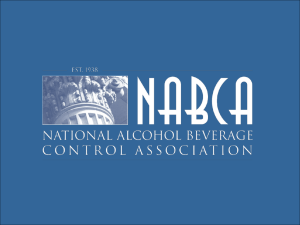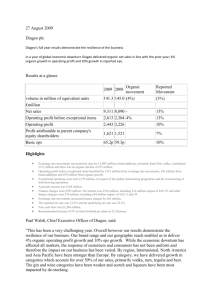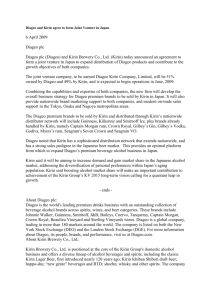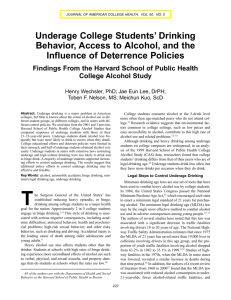PowerPoint - Alcohol Policy Consultant
advertisement
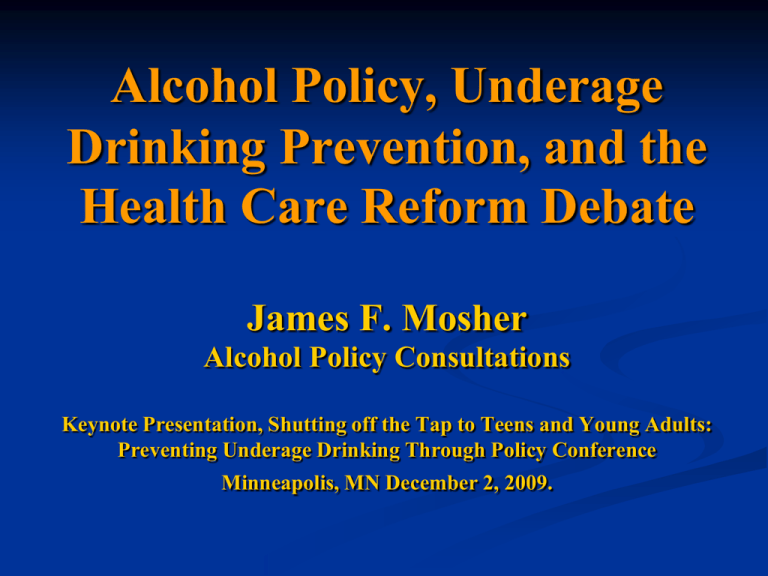
Alcohol Policy, Underage Drinking Prevention, and the Health Care Reform Debate James F. Mosher Alcohol Policy Consultations Keynote Presentation, Shutting off the Tap to Teens and Young Adults: Preventing Underage Drinking Through Policy Conference Minneapolis, MN December 2, 2009. Lessons from Alcohol Policy and Underage Drinking Prevention Lesson #1 Private industry’s focus on short-term profits can undermine public health outcomes. Diageo: The Innovator of the Distilled Spirits Industry Formed in 1997 when Guinness and Grand Metropolitan merged, becoming the largest distilled spirits company in the world. Determined to expand the U.S. market, which has been dominated by beer. The Diageo Strategy Engage the politicians, public officials, the medical profession, educators, parents, law enforcement agencies, among others to promote a “responsible” corporate image. Under the cover of that image, engage in predatory marketing practices targeting youth. “Captain Morgan maintains its relevance with consumers entering the drinking age because they can associate with the icon.” Chief Marketer, November 2005 Diageo: Competing with Beer Beer has significant marketing advantages over distilled spirits particularly for young drinkers: Advertising on network television; Lower tax rates; More retail outlets. The Answer Create a malt-based, low-alcohol beverage with distilled spirits branding that is appealing to young drinkers, particularly young women, and regulated as beer. Developing Brand Loyalty at an Early Age “Diageo rolled out Smirnoff Ice in the US market...it suddenly put the once-stodgy Smirnoff name on the tips of millions of echo boomers’ tongues” – (Impact, May 15, 2003) Echo Boomers: Americans born from 1980-1995 8 – 23 years old in 2003 “The beauty of this category is that it brings in new drinkers, people who really don’t like the taste of beer.” Marlene Coulis Director of New Products Anheuser-Busch Co. Advertising Age April 22, 2002 Who are “New Drinkers”? Average Age of First Use of Alcoholic Beverages among 12-17 year olds, 2004: 14.4 years old. Every day, 2,700 young people under 15 years old started drinking. Television Advertising Placement: Youth Audience Overexposure 35% 30% 25% Alcopop ads Distilled spirits Beer Industry average 20% 15% 10% 5% 0% 2006 Source: Center on Alcohol Marketing and Youth . “In our marketing activities, we never target people under the legal purchase age.” Diageo Corporate Citizenship Report, 2003 Alcopop Preference: 14-20 year old drinkers 5 State Survey, 4075 Respondents, 2004 Smirnoff Ice 14% 11% 54% Mike's Hard Lemonade Bacardi Silver Other Wolfson M. et al. “Flavored Malt Beverage Use in a Multi-state Sample of Adolescents”, Wake Forest University, December 2005 Alcopops aka Flavored “Malt” Beverages “Flavored malt beverages exhibit little or no traditional beer or malt beverage character. … Brewers … remove the color, bitterness, and taste that are generally associated with beer. … This leaves a base product to which brewers add various flavors, which typically contain distilled spirits, to achieve the desired taste profile.” Federal Alcohol and Tobacco Tax and Trade Bureau (TTB) Description of “Flavored Malt Beverages” (Alcopops) Minnesota Distilled Spirits Definition until 2006 “Distilled Spirits” means intoxicating liquors, including ethyl alcohol, hydrated oxide of ethyl, spirits of wine, whiskey, rum, brandy, gin, and other distilled spirits, including all dilutions and mixtures, for nonindustrial use. MN Stat. Ann. § 297G(7) Beverage Choice for 12th Grade Female Binge* Drinkers % binge drinkers 25 20 Liquor Beer Wine 15 10 5 *5+ drinks in one setting 07 20 05 20 03 20 01 20 99 19 97 19 95 19 93 19 19 91 0 Smirnoff Vodka Sales 1990 - 2006 (U.S., thousands of nine-liter cases) 9500 9000 8500 8000 7500 Smirnoff Vodka sales 7000 6500 6000 5500 5000 1990 1996 1999 2001 2003 2005 2007 Introduction of Smirnoff Ice Guy Smith “Reputation & Crisis Management” Expert 2000-2008: VP for Marketing Public Relations, Diageo 1998-1999: Special Advisor to President Clinton 1975-1992: VP-Corporate Affairs, Philip Morris Company Lessons from Alcohol Policy and Underage Drinking Prevention Lesson #2 Community environments have enormous impact on community members’ health outcomes. Underage Drinking Policies: Their Role in Changing Community Alcohol Environments INDIVIDUALS POPULATIONS Number of Drinks Consumed by Social Context Mean Number of Drinks 6 5 Alone 4 With 1 other person With 2 or more other people 3 2 1 0 Ages 12-14 NSDUH, 2009 Ages 15-17 Ages 18-20 “Four is all about the party!!!” Four Loko Facebook Page State Attorneys General Investigation Miller/Coors and Anheuser-Busch agree to remove stimulants from Sparks, Tilt and Bud Extra. Miller/Coors agrees to discontinue youthoriented marketing for Sparks. Price Comparison: Nonalcoholic vs. Alcoholic Energy Drinks $2.39/16 oz = $.15/oz ($4.00/32 oz = $.125/oz) $2.59/23.5 oz = $.11/oz Price Matters Alaska increased alcohol taxes in 1983 and 2002 resulting in 29% and 11% reductions in alcoholrelated mortality. Wagenaar et al. 2009 Place Matters Overconcentration: A link to youth violence Role of Policy in Affecting Underage Drinking Behavior Public and Institutional Policies Alcohol Availability Norms, Attitudes, Beliefs Derived from Wagenaar et al., 1986 Alcohol Use and Problems Lessons from Alcohol Policy and Underage Drinking Prevention Lesson #3 Underage drinking policy reform can only succeed through democratic, grassroots action. Alcopop Classification: Legislative and Regulatory Activity WA ME OR MN VT NY MI CT NE MD UT CA IL MO NM VA AR Alaska Hawaii Public health provisions enacted Public health provisions proposed Industry definition enacted Lessons from Alcohol Policy and Underage Drinking Prevention Lesson #4 Underage drinking prevention policy is grounded in a commitment to social justice. Lessons from Alcohol Policy and Underage Drinking Prevention Lesson #5 Underage drinking prevention policy is a unifying force in the body politic and bridges the divisions across our society. Prevention Paradigms Alcohol Industry Environmental Individual choice and free market Policy change and social context Profit is motivator Public health and social justice is motivator Industry controls policy agenda through elite politics Divide and isolate community members Communities control policy agenda through grassroots action Unite and inspire individuals to build community Y.O.Y.O. vs. W.I.T.H. WE’RE IN THIS TOGETHER

